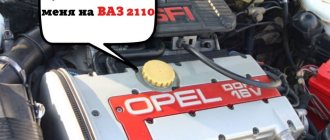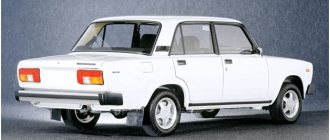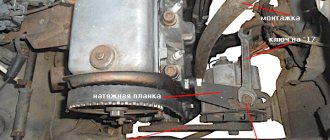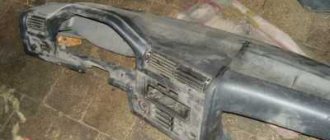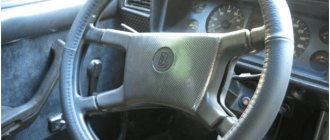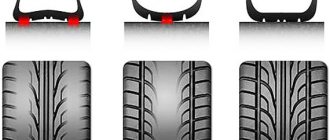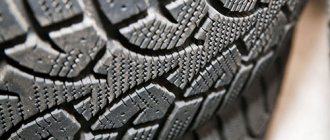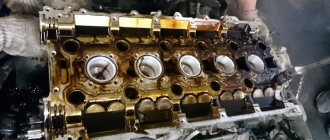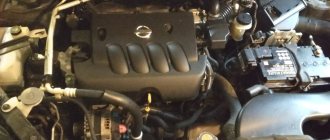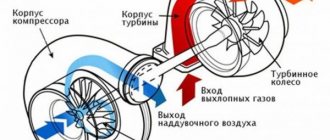Published: 01/28/2021
- IN THE TEAM - REPLACEMENT
- Is the game worth the candle?
- Registration canceled due to undocumented alteration
- Mechanical engine charging: what you need to know
- Installing boost on the engine
- svechi2_no_copyright
- City coat of arms
- Operating rules
- How is a turbine checked?
- Flaws
- How to install a turbine?
- Peculiarities of turbine operation
- Advantages and disadvantages
- Review (rating) of recommended candles for HBO
- All answers
- How does turbocharging work in a car?
- How to install a turbine?
Is the game worth the candle?
To sum up all of the above, there is practically no actual benefit in installing a turbine on a VAZ 2109. A full-fledged high-quality modification will be very expensive, but other options make no sense and the risk increases, at best, of saying goodbye to the car completely. It goes without saying that the engine must be absolutely in good working order and free of defects before installing the turbo kit. Otherwise, it will also have to be replaced.
The general disadvantages of installing a turbine on a VAZ carburetor also include the fact that the service life of the engine with such modifications is significantly reduced. And this is even with perfectly installed equipment according to all the rules. And also, it is worth observing the basic requirements for operation and preventive maintenance of the turbocharger itself. Since the most common cause of breakdowns is not factory defects or the fragility of the element itself, but rather improper use.
Installing a turbo on a VAZ 2114 where to start
Installing a turbine on any car begins with a painstaking study of the hardware. Chinese TURBINE for VAZ 2109 and Top subwoofer! We install a cheap TURBINE on a VAZ. Part. You can’t just come to the store and buy a ready-made set. And even if it is possible, the system will still have to be modified.
Turbocharged engine VAZ 2114
If you take on this task, consider the following:
- A number of stock units of the VAZ 2114 are not applicable for a car with a power exceeding 150 hp. It will not be possible to do without re-equipping the suspension and brakes, installing wider wheels with a turbo engine.
- Tuning foreign cars is partly easier if the model being tuned has “bigger” brothers with turbo engines. How to install a turbine on a D-240 engine. Detailed information about the product/service and supplier. A turbine on a VAZ is numerically expressed as 1 which nevertheless installed a turbine on. Tuning usually comes down to searching, purchasing and adjusting ready-made industrial components. It’s more difficult with Togliatti-made cars - they don’t install turbines on the Voila. Fortunately, in large towns there are tuning studios that develop and create tuning parts. True, their products are mainly unlicensed, so there will be difficulties with the legalization of configurations.
- The right choice of turbine is the key to successful turbo tuning. Before realizing your dream, we advise you to read short descriptions of the turbines used to modify the VAZ.
Mechanical engine charging: what you need to know
Let's start with the fact that installation of any type of supercharger (mechanical or turbocharging) is possible on both injection and carburetor engines. In both cases, a number of modifications to the power unit are expected, however, installing a turbine on the engine is somewhat more difficult and expensive compared to a compressor.
It becomes clear that a mechanical supercharger is a more affordable way to increase engine power; such a solution is easier to install on the engine, and the work can even be done independently. At the same time, the general principle of operation of the supercharger is quite simple.
The device can actually be compared to an attachment (generator, power steering pump or air conditioning compressor), that is, the unit is driven by the engine. As a result of the operation of a mechanical compressor, the air is compressed and enters the cylinders under pressure.
This allows the cylinders to be better purged (ventilated) from exhaust gas residues, cylinder filling is significantly improved, the amount of air in the combustion chamber increases, which makes it possible to burn more fuel and increase engine power.
Also, the compressor has a direct dependence on engine speed. The more the engine is revved, the more air is supplied to the combustion chambers and, accordingly, the power increases. At the same time, there is no pronounced effect of turbojam (turbolag), which is found on turbocharged engines. Turbo lag manifests itself in the form of a failure at low speeds, when the exhaust energy is not yet enough to spin the turbine and create the necessary pressure to effectively supply air to the cylinders.
In other words, all work is carried out comprehensively, which further allows the forced power unit to operate successfully and stably without significantly reducing its service life. Now let's look at some of the features of this installation.
Pros of installing a turbocharger
If you purchased a turbine for a carburetor engine of proper quality and no violations were made during the installation process, you can expect an improvement in the following engine performance indicators:
- Acceleration improves, dynamic characteristics increase
- Increased traction
- Reduced fuel consumption (due to faster acceleration)
- Overcoming climbs and obstacles will become more comfortable
- An increase in air density in the cylinders leads to complete combustion of gasoline, making exhaust gases less hazardous to the environment
As an example of changes in engine power characteristics, you can use the data obtained after testing a 1.5-liter carburetor engine of a VAZ 2183 car.
| Standard indicators | Turbocharged | |
| Power, kW/hp at rpm | 51.5/70 at 5600 | 78/106 at 5600 |
| Maximum torque, N.m at rpm | 107 at 3500 | 144 at 4000 |
| Maximum speed, km/h | 155 | 190 |
| Acceleration from standstill to 100 km/h, s | 13,8 | 10,6 |
| Fuel consumption, l/100 km | 5,5 | 7,7 |
Installing boost on the engine
Installation of the turbine should be carried out only by those motorists who have sufficient experience and knowledge in the technical features of the operation of the entire system. Direct installation instructions are as follows:
After purchasing a supercharger, you need to unpack it and conduct a visual inspection - the body must be intact and have no deformed areas. It is also necessary to check the technical condition of the oil supply hole. Check carefully - there should not be even the smallest parts inside the boost. Before directly installing the turbine, it is necessary to fill it with oil. The type and characteristics of the oil play an important role in determining the performance of the device and the reliability of the entire system. The turbine should be positioned so that the oil supply hole is at the top. Oil is poured into the hole, which should fill the turbine to the brim. Using a hand pump, you need to create pressure that pushes the oil into the interior and lubricates all the internal parts. During pumping, a hissing sound may be heard - this is normal. The procedure is performed several times, after which all the oil is poured through the drain hole. The oil supply hole is located strictly vertically and is connected to the installed compressor on the engine
It is necessary to pay attention to the inclination of the feed hole angle. The permissible deviation from the norm should be within 10-15 degrees. The car owner must make sure that the oil drains freely, without additional force. For ease of installation of the turbine, it is recommended to remove the heat shield, generator and exhaust manifold
After this, all antifreeze is drained. A hole is carefully drilled into the engine, into which a fitting with a thin layer of sealant is then installed. A heat shield, the turbine itself and the intake manifold are installed. The next step is to attach the treatment hose to the fitting and turbine, and then install the external wastegate. A silicone hose is attached to the fitting, which is cut in half and connected to the T-fitting. After this, all that remains is to install the intake piping and intercooler.
The car owner must make sure that the oil drains freely, without additional force. For ease of installation of the turbine, it is recommended to remove the heat shield, generator and exhaust manifold. After this, all antifreeze is drained. A hole is carefully drilled into the engine, into which a fitting with a thin layer of sealant is then installed. A heat shield, the turbine itself and the intake manifold are installed. The next step is to attach the treatment hose to the fitting and turbine, and then install the external wastegate. A silicone hose is attached to the fitting, which is cut in half and connected to the T-fitting. After this, all that remains is to install the intake piping and intercooler.
And a visual video with the installation of a turbine on a VAZ 2109 engine:
After installing the turbocharger, it is necessary to conduct an initial test of the functionality of the entire system. To do this, you need to start the engine from the starter. In order for the starter to be able to crank the engine, but not start it, the car owner must remove the voltage wires. In this case, the oil pressure sensor will go out, and the pressure on the oil supply line will drop significantly. If the entire system is working normally, you need to start the engine and leave it running for 10-15 minutes at idle speed.
The first thousand to one and a half kilometers must be carried out in run-in mode. In this case, the running-in mode should be such that the turbocharging does not develop a pressure of no more than 0.5 bar. Drivers who do not have a cabin pressure sensor installed in their vehicle should not exceed 50% of the rev limit. Also, car enthusiasts should remember that the turbo must cool before stopping the engine completely.
The diagram below allows you to see what place it occupies in the system.
How to Install a Turbine on a VAZ 2107 Carburetor
Turbine for VAZ 2107
According to tuning specialists, the turbine on the VAZ 2107 is not a business that appreciates, from the category of those about which they say “the production work is not needed.”
The idea of a turbine in itself is not bad, and with its implementation you can significantly increase engine power (for example, a 2-liter engine up to 700 hp) and torque on almost any model. It is only on VAZ vehicles that this is problematic.
The features of a classic carburetor engine are such that installing a turbine is quite difficult, troublesome and expensive. When installing a turbine on VAZ models, it is necessary to have an intercooler (to cool the air heated by the turbine), which still does not give the expected effect. Then. The turbine on the VAZ 2107, like other classics, is unsafe for installation, unlike the compressor. There is a great danger that the exhaust manifold cannot withstand the high pressure created by the turbine. What does this mean? no need to explain. Having decided to install a turbine on your forward-thinking (or overlooked) VAZ 2107, sooner or later, you will have to change (or change) the engine to an injector.
All this will take hundreds of hours and tens of thousands of money. The question is in the name of what? It's clear that you are a greedy tuner and decided to get something like this:
(1.7 liter engine from Niva, turbine, 5-speed manual transmission, front brake discs with perforation, rear discs, rims.R15, Goodyear Tire F1 tires 195x50, body kit, rear lighting neon lining, JOM leather sports seats, salon equipment)
https://youtube.com/watch?v=5yyMEMSvleI
VAZ 2107 turbo carburetor!!!!
VAZ 2107 volume 1.6 l carburetor. turbine from skyline!! completely fucked up.
DESIGN REVIEW VAZ 2101 1.6 turbo carburetor 2014 / turbo carburetor review
Hi all! In this video I will talk about the design of the turbo engine in our design. Enjoy watching.
And if you want, like any driver, to improve engine performance even at traffic lights, and not accelerate by 20 seconds and at least 8-10, take an interest in the “Kit-kit” (0.5 bar compressor, increases power to 45-50%). Drive pump installation kits have been developed for all domestically produced models. They are characterized by their small size, low noise level in operation and high reliability.
Structurally, the supercharger consists of two parts: a centrifugal compressor and a high-speed multiplier.
Drive is via a poly-V belt from the engine crankshaft pulley. The compressor is not serviced during operation
When installing on foreign cars, you can orient the direction of the cochlea head relative to the position of the air duct.
The outer diameter at the compressor inlet is 74 mm, at the outlet. 62 mm with a coil diameter of 195 mm. The high-speed multiplier is assembled on rolling bearings of a special high-speed series. Replacement is carried out every fifty thousand kilometers of the car. Torque is transmitted by a PJ series polypropylene belt. Replace every fifty thousand.
The supercharger is almost silent during operation. Oil and coolant are not supplied. When installing a supercharger, there is no need to make any changes to the engine design, with the exception of pressure parameters above 0.5 bar.
Pay attention to how to determine the wear of the cross on a VAZ 2106 and VAZ 2107
City coat of arms
The heraldic description of the first coat of arms of Vereya, approved in 1782, reads: “In the first part of the shield is the coat of arms of Moscow. In the second part, in a silver field in a wild forest, there are two oak gateways with hanging gold hooks, signifying the name of this city.” Currently, the third coat of arms of Vereya has been approved in chronological order. Heraldic description: “The modern status territorial crown - golden, walled with three prongs - symbolizes Vereya as an urban settlement. The crown is decorated with a rim of precious stones, as a sign that from 1432 to 1486. Vereya was the center of an appanage principality.”
Operating rules
Before installing a turbine on your engine, you need to understand the conditions for using such units. By following them, you can increase the “life” of motors.
Proper operation of turbocharged engines requires compliance with the following recommendations:
Check the oil level regularly
There is a lot of advice on how to properly operate turbojet engines. However, the main condition is to regularly check the oil.
Lack of lubrication leads to rapid wear of the turbine bearings, as a result of which it soon stops working.
In addition, rapid oil consumption indicates a problem in the engine. The oil pump or other part may have failed.
When starting, do not hold the gas pedal for long
Turbocharged engines reach maximum pressure already at low speeds. Therefore, press the gas pedal for a long time. Otherwise, the turbine will run at idle speed, which shortens its service life.
Use only high quality oil
Poor quality oil is the second most common cause of rapid turbine wear
And it doesn’t matter whether it is installed on a gasoline engine or a diesel one. Moreover, such lubrication negatively affects the condition of the engine.
It is necessary to fill only with the oil recommended by the manufacturer of a particular power plant.
It is also important to note that the type of lubricant used on turbocharged engines differs from the fluid used on “atmospheric” units. This is explained by the fact that in the former a higher level of pressure is created, as a result of which the requirements for oil quality increase
This circumstance must be taken into account when boosting the “atmospheric” engine.
It is not recommended to use a different brand of lubricant, even if it has similar characteristics.
Be sure to check the condition of the motor after repair
First of all, you need to pay attention to the presence of oil and its composition: the liquid should be transparent. Next, the operation of the crankshaft is checked with the engine turned off.
And the last thing: you need to start the engine and keep it idling for 5-10 minutes, carefully listening for unusual sounds, the presence of extraneous knocks and the like.
Use only high-quality diesel fuel
In order for a diesel engine equipped with a turbine to retain its original characteristics, it is necessary to purchase only high-quality fuel. Low-grade fuel has many impurities that quickly clog the fuel system. As a result, the level of power developed by the engine decreases.
To level out its decline, the turbine begins to work at the limit of its own capabilities, which provokes rapid wear of the unit.
In cold weather, the engine should run at idle speed.
At low temperatures, the oil becomes more viscous. Therefore, it is recommended to start the turbocharged engine and keep it at idle so that the lubricant begins to circulate inside the unit.
In addition, it is not recommended to immediately stop turbojet engines in the cold. Before turning off, they also need to idle for some time. This recommendation is explained by the fact that at high speeds in power units the temperature rises to maximum values.
Therefore, a sudden shutdown of the engine can provoke a temperature drop, which reduces the service life of the installation and turbine.
Regularly rev the engine at high speeds
The turbine must operate regularly. Otherwise, it will soon fail. It is recommended to operate the engine at high speeds at least once a week. As a result of the operation of the supercharging system, a process of self-cleaning occurs.
Difficulties in installing a turbine on a carburetor engine
- The process of installing a turbine is in many ways reminiscent of the procedure on a fuel-injected internal combustion engine (installation of an intercooler, turbocharger, turbine control elements, etc.). The main difficulties are related to the carburetor.
- Due to the fact that the fuel mixture is supplied to the cylinders through jets, when a turbine is installed on a carburetor engine, it is necessary to change them to others of a larger diameter so that the mixture does not become too lean. And choosing non-original jets for a carburetor and ensuring its normal operation in all modes is very difficult.
These are the main problems that you will have to face when installing a compressor on a carburetor engine. But besides this, additional difficulties are possible, which will depend on the car model, as well as on its operating modes.
Of the most important advantages of such an installation, the following are worth highlighting:
- Reduced fuel consumption with proper use of the vehicle during everyday driving. We are talking about the ability to increase torque, which, in turn, will significantly reduce the frequency of gear shifts to lower ones on busy city roads in dense traffic. Again, this will reduce fuel consumption.
- Reduced noise during engine operation, since there is no need to turn the unit to high speeds. Also, with comprehensive tuning, it is possible to additionally and significantly improve the performance of the engine;
How is a turbine checked?
Before installing the turbine, it is strongly recommended to change the oil. In addition, the oil and air filters must be replaced. The sequence for checking the turbocharging system is as follows:
- the turbine should be inspected for oil leaks (this applies to both the part through which oil is supplied and the part through which it drains from the turbine);
- All air ducts are also carefully inspected. None of them should contain dirt or foreign objects;
- if the machine is equipped with a catalyst, then it should also be checked for wear (excessive exhaust from a worn-out catalyst can significantly worsen the operation of the turbine; it simply cannot cope with the large volume of incoming gas);
- Finally, you should check whether the turbine rotor rotates normally. The hum produced by the rotor should be uniform. There should be no extraneous sounds in it: creaking, whistling, etc.
So, installing a turbine on a VAZ 2106 is a long and painstaking process. In some situations, instead of a full-fledged turbine, you can think about installing a turbocharger. This is the least expensive and simplest option. Well, if the car owner has firmly decided to install a turbine on his “six”, then he should prepare for a serious modernization of the engine and serious financial expenses.
Is it worth it to install the turbine yourself?
This smoothly leads to the next question: is it possible to install a turbine with your own hands? The answer is theoretically possible, but highly not recommended. Since the installation and configuration of such a system is quite labor-intensive and complex, complete tightness is necessary, and during the installation process the ingress of oil, sand and other small particles is unacceptable, since all this can clog the impeller and cause the turbine to fail, and not only from standing still.
Therefore, one of the most important points is the presence of an experienced technician who knows exactly what needs to be done and how and will be able to advise in detail on all issues in advance and during the tuning process. This is especially true for high-pressure turbocharging, where it is better for an amateur not to meddle at all, for the sake of his own safety and the safety of the vehicle.
It is also worth remembering that the simplest supercharging will most likely not give any noticeable result. And for something more effective, a number of other car systems will have to be modified. At a minimum, the brake system, transmission and air filter system, which will significantly increase the tangible financial investment.
Flaws
Today there are the following ways to solve the problem of turbocharging inertia:
- biturbocharging (double supercharging);
- turbine with adaptive geometry;
- combined boost.
Twin turbocharging uses two small turbines that together operate much faster than one of the nominal size. The number of cylinders is distributed equally between these turbines. An analogue of such a system could be the use of several compressors that start moving at different engine speeds, each in its own mode.
A turbine with adaptive geometry is able to change the size of the intake port and thereby regulate the flow rate of exhaust gases, which also improves the efficiency of the system.
Combined charging consists of a turbocharger and a mechanical supercharger. The supercharger creates the required pressure at low speeds, but as soon as the speed increases to a certain value, the turbocharger comes into operation.
Heat. As already mentioned, compressing air entails heating it, which does not affect the operation of the engine in the best way. Therefore, it is often necessary to connect additional cooling, and this consumes some of the energy.
However, despite these disadvantages, turbocharging is an excellent way to increase the power and efficiency of an internal combustion engine, as well as its economy. In addition, many years of experience of specialists shows that options for improving this system have not yet been exhausted.
Video about the features and principles of turbocharging
Disadvantages of the turbocharging system
Before installing additional equipment, you need to consider not only the pros, but also the disadvantages of such an upgrade. Often, with a detailed study of all the subtleties, the inappropriateness of improving power indicators becomes obvious.
- In some cases, spark plugs may need to be replaced.
- Increasing power will inevitably accelerate wear on engine parts.
- Finding a suitable turbine can take a long time (especially for domestic cars)
- The cost of work and components is very high, sometimes the amount is equivalent to the cost of a car
- In the event of a breakdown, reinstalling the turbine will be expensive
- After traveling at high speed, the engine will need cooling
- Increased fuel consumption. On average, this figure increases by 15 - 20 percent.
If you have decided to upgrade your car engine with a DIY turbocharger, you first need to determine whether the selected equipment is suitable for your car.
The best solution would be to consult a specialist who will make the necessary calculations and select the desired turbine model.
How to install a turbine?
Before starting work, you need to check whether the necessary consumables are available. The use of sealants when working with pipelines is strictly prohibited. When exposed to high temperatures, they liquefy and lose their original properties.
Pieces of peeling sealant will sooner or later get inside the turbine and lead to failure. A self-installed turbine is the result of painstaking work; you need to carefully monitor whether there are any foreign particles or liquids in the oil.
Installation sequence:
- First of all, components are replaced - oil and air filters and the oil itself.
- The oil line hole is thoroughly washed, foreign particles and sand are removed.
- All damaged or failed oil lines and pipes must be replaced with new ones.
- Next, you need to remove the breather from the engine, clean it thoroughly and rinse it.
- Afterwards, the supply lines are washed and the oil is drained.
- Using a special syringe, it is necessary to treat the contacting connections of the turbine with oil. Lubrication can be done with the engine oil of the engine on which the turbine is planned to be installed.
- The turbocharger is installed taking into account the location of the oil pipeline. The presence of kinks and a horizontal position of the oil pipeline is unacceptable.
Peculiarities of turbine operation
In comparison with those powered by a crankshaft drive, the advantages of a turbine are that it does not take away, but uses the energy of the by-products of its work. It is cheaper to manufacture and more economical to operate.
Although the technical design of a diesel engine turbine is practically no different from systems for gasoline engines, it is more common on diesel engines. The main feature is the operating modes. Thus, less heat-resistant materials can be used for diesel engines, since the exhaust gas temperature averages from 700 °C in diesel engines and from 1000 °C in gasoline engines. This means that you cannot install a diesel turbine on a gasoline engine.
On the other hand, these systems are also characterized by different levels of boost pressure. It should be taken into account that the performance of the turbine depends on its geometric dimensions. The pressure of the air injected into the cylinders consists of two parts: 1 atmosphere of ambient pressure plus excess pressure created by the turbocharger. It can vary from 0.4 to 2.2 or more atmospheres. Considering that the principle of operation of a turbine on a diesel engine provides for the supply of a larger volume of exhaust gases, the design for a gasoline engine also cannot be installed on diesel engines.
Turbine check
Before installing the turbocharger, it is recommended to change the oil, as well as the air and oil filters. The turbine is checked in the following order:
- the oil drain and supply parts of the compressor are inspected for the presence of foreign impurities;
- the catalyst is checked (excess exhaust gases will negatively affect the operation of the compressor);
- all air supply channels are inspected for dirt and blockages;
- The rotor rotation speed is checked.
In other words, checking a turbocharger comes down to:
- control of the quality and quantity of gases released from the collector;
- checking the quality of fresh air supply to the compressor;
- checking the output of hot gases from the turbine;
- checking the compressed air output from the compressor.
Video: testing a tractor turbine on a VAZ 2107
Thus, installing a turbocharger on a VAZ 2107 is quite complicated and expensive. Therefore, it is easier to immediately turn to professionals. However, before this, it is necessary to carefully evaluate the feasibility of such tuning.
Turbine for VAZ 2106
In fact, every car owner of our time is trying to somehow modernize his car. People strive to improve the driving properties of a car almost immediately after purchasing it. For the same purpose, a turbine is installed on the VAZ 2106.
Increasing engine power is the main process of modifying a car. You can endlessly install pumped parts into the engine, but without installing a turbocharging system, the car will not become as powerful as we would like.
Advantages and disadvantages
Turbocharged engines have their strengths and weaknesses, so you shouldn’t believe automakers’ statements about their clear advantage. Before deciding to choose a car equipped with a turbocharged gasoline engine, you should weigh the pros and cons.
Advantages
The main advantage of a turbocharged engine is its increased power, and one cannot but agree with the manufacturers on this. In terms of power, with a similar cylinder volume, the unit exceeds atmospheric engines by 20–30%. Additional advantages of installing a turbocharger on a motor are as follows:
- Increasing operating efficiency by optimizing the combustion process of the airless mixture in the cylinders. Thanks to this, fuel consumption to ensure the operation of a similar amount of naturally aspirated engine horsepower is significantly reduced.
- Reduced noise and vibration levels while driving.
- Environmentally friendly. Efficient combustion of fuel inside the cylinders significantly reduces the amount of emissions into the atmosphere through the exhaust pipe. Experts say that the introduction of new emission standards in Europe and the United States has increased the production of cars with turbocharged gasoline engines by 25%.
- Compact sizes. An engine with three or even two cylinders is comparable in power to a four-cylinder naturally aspirated one. Thanks to its optimal dimensions, such an engine has a greater number of placement options in the car.
Flaws
For all its advantages, turbocharging also has some negative sides:
- Increased sensitivity to fuel quality. This implies the need to use higher grade gasoline. A turbocharged engine will quickly fail if forced to run on 92 gasoline.
- With active use of the turbine, fuel consumption increases by 1.5 times. Fans of driving in the "gas to the floor" style will fill the tank of their car twice as often.
- The need for frequent oil changes. Lubricant is added to the engine and directly to the turbocharger unit, so its consumption increases. The requirements for the brand of oil are also quite stringent: you can only use high-quality synthetic brands, the cost of which is an order of magnitude higher than mineral or semi-synthetic lubricants. To this should be added the need for frequent oil changes: every 8,000 kilometers. While in atmospheric engines the procedure can be carried out after 12 and even 15 thousand kilometers. Untimely replacement of oil and filters will lead to changes in turbine parameters and its rapid failure.
- Expensive repairs. Components for turbocharged engines are quite expensive, so their repair requires a significant investment. The cost of repairs increases further due to the lack of qualified service station workers. Not every car service center will repair a turbocharged engine, and you will have to pay 40–50% more for the qualifications of the technicians. A major overhaul of a turbocharged engine is required every 150–200 thousand kilometers.
- Features of operation. A car with a turbo engine must be started and stopped correctly. After starting, the engine must idle, and the older the car, the longer the “run” is needed. After stopping the car, you should also not immediately turn off the engine.
- Manifestation of the “turbo lag” effect. This is the name given to a characteristic failure when the car reacts sluggishly to pressing the gas pedal. The engine “does not pull” at low speeds, as a result the car cannot move sharply. With heavy traffic and difficult road conditions in megacities, this is a rather dangerous phenomenon. To solve the problem, the designers propose installing two turbines on the engine, one of which will operate at low speeds due to being equipped with an electric drive. This will reduce the risk of turbo jams, but will additionally increase the cost of the engine and at the same time reduce its reliability.
A turbocharged engine is more likely to undergo expensive repairs and require high-quality fuel
How does turbocharging work in a car?
The energy of the exhaust gases in the engine is directed to the supercharger turbine wheel, which, under the influence of gases, rotates in its housing, which has a special shape to improve the kinematics of the passage of exhaust gases.
The temperature here is very high, and therefore the housing and the turbine rotor itself, together with its impeller, are made of heat-resistant alloys that can withstand prolonged high-temperature exposure. Also recently, ceramic composites have been used for these purposes.
The compressor wheel, rotated by the energy of the turbine, sucks in air, compresses it and then pumps it into the cylinders of the power unit. In this case, the rotation of the compressor wheel is also carried out in a separate chamber, where the air enters after passing through the air intake and filter.
Video - what a turbocharger is needed for and how it works:
Both turbine and compressor wheels, as mentioned above, are rigidly fixed to the rotor shaft. In this case, the shaft rotates using plain bearings, which are lubricated with engine oil from the main engine lubrication system.
Oil is supplied to the bearings through channels that are located directly in the housing of each bearing. In order to seal the shaft from oil entering the system, special sealing rings made of heat-resistant rubber are used.
Of course, the main design challenge for engineers when designing turbochargers is organizing their efficient cooling. For this purpose, in some gasoline engines, where thermal loads are highest, liquid cooling of the supercharger is often used. In this case, the housing in which the bearings are located is included in the dual-circuit cooling system of the entire power unit.
Another important element of the turbocharging system is the intercooler. Its purpose is to cool the incoming air. Surely many of the readers of this material will wonder why cool the “outboard” air if its temperature is already low?
The answer lies in the physics of gases. Cooled air increases its density and, as a result, its pressure increases. In this case, the intercooler is structurally an air or liquid radiator. Passing through it, the air reduces its temperature and increases its density.
An important part of a car's turbocharging system is the boost pressure regulator, which is a bypass valve. It is used to limit the energy of engine exhaust gases and directs some of them away from the turbine wheel, which allows you to regulate the boost pressure
The valve drive can be pneumatic or electric, and its operation is carried out due to signals received from the boost pressure sensor, which are processed by the vehicle's engine control unit. It is the electronic control unit (ECU) that sends signals to open or close the valve depending on the data received by the pressure sensor.
In addition to the valve that regulates the boost pressure, a safety valve can be installed in the air path directly after the compressor (where the pressure is maximum). The purpose of its use is to protect the system from surges in air pressure, which can occur in the event of a sudden shutdown of the engine throttle.
Excess pressure arising in the system is released into the atmosphere using a so-called bluff valve, or is directed to the inlet of the compressor by a bypass valve.
How is oil supplied to the turbine?
A complete turbocharging system cannot function without oil. So the driver who decides to install a turbine will have to solve this problem. When the turbine is installed, a special adapter is screwed to it (such adapters usually come complete with turbines). A heat dissipation shield is then installed on the intake manifold. Oil is supplied to the turbine through an adapter onto which a silicone tube is first placed. In addition, the turbine must be equipped with a cooler and an air tube through which air will flow into the manifold. Only in this way can an acceptable temperature of the oil supplied to the turbine be achieved. It should also be said here that sets of tubes and clamps for supplying oil to turbocharging systems can be found in spare parts stores.
A set of turbine pipes will save the driver a lot of time
This set costs from 1200 rubles. Despite the clearly inflated price, such a purchase will save the car owner a lot of time, since he will not have to bother with cutting and adjusting silicone tubes.
About the pipes
Pipes are needed not only for supplying oil. Exhaust gases from the turbine also need to be removed. To remove excess gas not used by the turbine, a massive silicone pipe on steel clamps is used. In some cases, a whole system of silicone pipes is used to remove the exhaust (their number is determined by the design of the turbine). Usually there are two of them, in some cases - four. Before installation, the pipes are carefully inspected for internal contamination. Any, even the smallest, speck that gets into the turbine can cause a breakdown. It is for this reason that each pipe is thoroughly wiped from the inside with a cloth soaked in kerosene.
Exhaust pipes are usually made of silicone
When choosing clamps for pipes, you should remember: silicone is not a very durable material. And if, when installing the pipe, you tighten the steel clamp too much, it can simply cut the pipe. For this reason, experienced motorists recommend not using steel clamps at all, but instead using clamps made of special high-temperature plastic. It provides reliable fastening and does not cut the silicone.
How to install a turbine?
Before starting work, you need to check whether the necessary consumables are available. The use of sealants when working with pipelines is strictly prohibited. When exposed to high temperatures, they liquefy and lose their original properties.
Pieces of peeling sealant will sooner or later get inside the turbine and lead to failure. A self-installed turbine is the result of painstaking work; you need to carefully monitor whether there are any foreign particles or liquids in the oil.
- First of all, components are replaced - oil and air filters and the oil itself.
- The oil line hole is thoroughly washed, foreign particles and sand are removed.
- All damaged or failed oil lines and pipes must be replaced with new ones.
- Next, you need to remove the breather from the engine, clean it thoroughly and rinse it.
- Afterwards, the supply lines are washed and the oil is drained.
- Using a special syringe, it is necessary to treat the contacting connections of the turbine with oil. Lubrication can be done with the engine oil of the engine on which the turbine is planned to be installed.
- The turbocharger is installed taking into account the location of the oil pipeline. The presence of kinks and a horizontal position of the oil pipeline is unacceptable.
